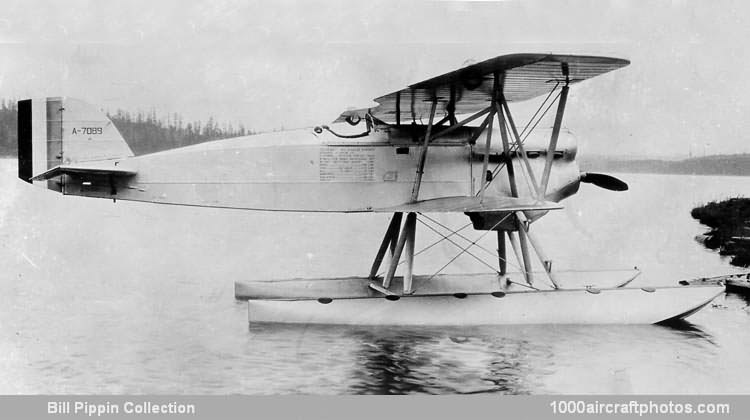06/30/2011. Remarks by Johan Visschedijk: "In developing its first original fighter, the Boeing Airplane Company of Seattle, Washington, was influenced by two streams of experience. The company had already won a contract to build 200 Thomas Morse MB-3As for the USAAS, and this work brought intimate acquaintance with contemporary American practice in single-seat, high-performance fighter design; in addition, a comprehensive study had been made of European production techniques, leading Boeing engineers to conclude that the Fokker D.VII had a number of particularly meritorious features. A number of these features could be detected in the Boeing Model 15, which first flew on June 2, 1923, and was tested by the USAAS as the XPW-9. Its success launched Boeing into the production of a series of fighters which were to be its major activity for the next decade.
USN interest in the Model 15 followed closely upon USAAS production orders, and a contract for sixteen (serials A-6884 to A-6893) was placed early in 1925. The first ten, delivered between December 1 and 22, 1925, were designated FB-1 and were virtual duplicates of the USAAS PW-9s, with the 435 hp Curtiss D-12 engine and an armament of two 0.30 in (7.62 mm), or one 0.30 in and one 0.50 in (12.7 mm) machine guns. They went to the USMC, serving at first with Squadrons VF-1M, VF-2M and VF-3M; nine of the ten were assigned to the Expeditionary Force in China in 1927/28, operated by VF-10M (VF-3M redesignated) and the tenth was then assigned to VO-8M in San Diego.
The first Boeing fighters for naval use were not equipped for carrier operations, but two Boeing Model 53 FB-2s, serials A-6894 to A-6895, were suitably modified, with strengthened fuselage structure and cross-axle landing gear. Three Model 55 FB-3s, serials A-6897, A-7089, A-7090, were similar, but had the FB-1 type split-axle landing gear and provision for twin float operation. They also had 510 hp Packard 1A-1500 engines in place of the original Curtiss power plant. Another experimental version was the model 54 FB-4, delivered to the USN with a 450 hp Wright P-1 radial engine (and provision for floats) but converted later to the FB-6 with a 400 hp Pratt & Whitney Wasp.
Succeeding the FB-1 as the next production fighter for the Navy was the model 67 FB-5, first flown on October 7, 1926. This variant had a 520 hp Packard 2A-1500 engine, in a cowling similar to that originated on the FB-3, and increased wing stagger, the top wing being moved forward and the lower wing aft. Aerodynamically balanced rudders with increased area were also introduced on all but the first FB-5. Production totaled 27 serials A-7101 to A-7127, and all were delivered on January 21,1927; the delivery process was probably unique, the aircraft being loaded on barges at Boeing's water's edge factory in Seattle and ferried to the carrier USS Langley in Seattle harbor, making their first flights from the carrier deck. They initially equipped Navy Squadrons VF-1B and VF-6B aboard the Langley, and later VF-3B flew FB-5s from the Lexington before a number were passed on to Marine units, including VF-6M at San Diego.
Plans to produce an Model 67A FB-7 with a Wasp engine were passed over after the Navy had tested the XF2B-l, an extensive redesign of the initial Boeing fighter to take advantage of the new engine."
